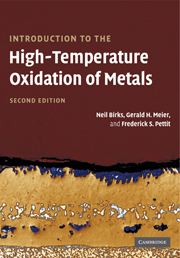Book contents
- Frontmatter
- Contents
- Acknowledgements
- Preface
- Introduction
- 1 Methods of investigation
- 2 Thermodynamic fundamentals
- 3 Mechanisms of oxidation
- 4 Oxidation of pure metals
- 5 Oxidation of alloys
- 6 Oxidation in oxidants other than oxygen
- 7 Reactions of metals in mixed environments
- 8 Hot corrosion
- 9 Erosion–corrosion of metals in oxidizing atmospheres
- 10 Protective coatings
- 11 Atmosphere control for the protection of metals during production processes
- Appendix A Solution to Fick's second law for a semi-infinite solid
- Appendix B Rigorous derivation of the kinetics of internal oxidation
- Appendix C Effects of impurities on oxide defect structures
- Index
- References
8 - Hot corrosion
Published online by Cambridge University Press: 05 June 2012
- Frontmatter
- Contents
- Acknowledgements
- Preface
- Introduction
- 1 Methods of investigation
- 2 Thermodynamic fundamentals
- 3 Mechanisms of oxidation
- 4 Oxidation of pure metals
- 5 Oxidation of alloys
- 6 Oxidation in oxidants other than oxygen
- 7 Reactions of metals in mixed environments
- 8 Hot corrosion
- 9 Erosion–corrosion of metals in oxidizing atmospheres
- 10 Protective coatings
- 11 Atmosphere control for the protection of metals during production processes
- Appendix A Solution to Fick's second law for a semi-infinite solid
- Appendix B Rigorous derivation of the kinetics of internal oxidation
- Appendix C Effects of impurities on oxide defect structures
- Index
- References
Summary
Introduction
In addition to attack by reactive gases, alloys used in practical environments, particularly those involving the combustion products of fossil fuels, undergo an aggressive mode of attack associated with the formation of a salt deposit, usually a sulphate, on the metal or oxide surface. This deposit-induced accelerated oxidation is called hot corrosion. The severity of this type of attack, which can be catastrophic, has been shown to be sensitive to a number of variables including deposit composition, and amount, gas composition, temperature and temperature cycling, erosion, alloy composition, and alloy microstructure. A number of comprehensive reviews on hot-corrosion have been prepared. The purpose of this chapter is to introduce the reader to the mechanisms by which hot corrosion occurs. The examples used will be those associated with Na2SO4 deposits which are often encountered in practice. However, the effects of some other deposits will be briefly described at the end of this chapter.
Once a deposit has formed on an alloy surface the extent to which it affects the corrosion resistance of the alloy will depend on whether or not the deposit melts, how adherent it is and the extent to which it wets the surface, and the status of equilibrium conditions at the interfaces. A liquid deposit is generally necessary for severe hot corrosion to occur although some examples exist where dense, thick, solid deposits have, apparently, resulted in considerable corrosion.
- Type
- Chapter
- Information
- Introduction to the High Temperature Oxidation of Metals , pp. 205 - 252Publisher: Cambridge University PressPrint publication year: 2006
References
- 9
- Cited by



